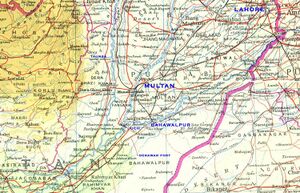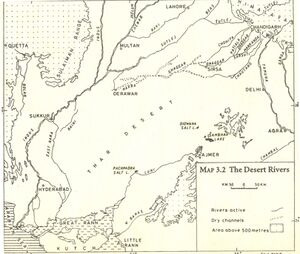Derawar Fort is a large square fortress in Bahawalpur, Punjab, Pakistan. The forty bastions of Derawar are visible for many miles in Cholistan Desert. The walls have a circumference of 1500 metres and stand up to thirty metres high.
Location of Derawar Fort is in Bahawalpur (Hindi: बहावलपुर, Punjabi/Urdu: بہاولپور) District in the Punjab province in Pakistan. Bahawalpur was also a princely state, stretching along the southern bank of the Sutlej and Indus Rivers, with its capital city at Bahawalpur.
The historic Derawar Fort, enormous and impressive structure in the heart of Cholistan desert, is rapidly crumbling and if the immediate preventative measures are not taken, the edifice will be destroyed and the historians, researchers and sightseers d it is the string for shabanu's, it also has a widseprived of the view of the legacy of the bygone era. Like so many other historic sites in the country, Derawar Fort is yet another sign of old times we are poised to lose forever due to the apathy of those who are responsible for its upkeep and preservation.
Derawar fort was built by Rai Jajja Boota. a Rajput ruler. The fort was built in 9th century AD as a tribute to Rawal Deoraj Bhatti, a Rajput sovereign King of Jaisalmer and Bahawalpur area. Initially, it was known as Dera Rawal, later it was termed as Dera Rawar and with the passage of time it turned to be Derawar, the present name of fort.
James Tod writes Beeji Rao had succeeded as BhattiChief in S. 870 (A.D. 814). He commenced his reign with the teeka-dour against his old enemies, the Barahas, whom be defeated and plundered. In S. 892, he had a son by the Boota queen, who was called Deoraj. The Barahasand Langahas once more united to attack the Bhatti prince ; but they were defeated and put to flight. Finding that they could not succeed by open warfare, they had recourse to treachery. Having, under pretence of terminating this long feud, invited young Deoraj to marry the daughter of the Baraha chief, the Bhattis attended, when Beeji Rai and eight hundred of his kin and clan were massacred.
Deoraj escaped to the house of the Purohit (of the Barahas, it is presumed), whither he was pursued. There being no hope of escape, the Brahmin threw the Brahminical thread round the neck of the young prince, and in order to convince his pursuers that they were deceived as to the object of their search, he sat down to eat with him from the same dish. was invested and taken, and nearly every soul in it put to the sword, so that the very name of Bhatti was for a while extinct.
Deoraj remained for a long time concealed in the territory of the Barahas ; but at length he ventured to Boota, his maternal abode, where he had the happiness to find his mother, who had escaped the massacre at Tanot. She was rejoiced to behold her son's face, and " waved the salt over his head," then threw it into the water, exclaiming, " thus may your enemies melt away !" Soon tired of a life of dependence, Deoraj asked for a single village, which was promised ; but the kin of the Boota chief alarmed him, and he recalled it, and limited his grant to such a quantity of land as he could encompass by the thongs cut from a single buffalo's hide : and this, too, in the depth of the desert. For this expedient he was indebted to the architect Kekeya, who had constructed the castle of Bhatner.
This deception practised by the Bhatti chief to obtain land on which to erect a fortress is not unknown in other parts of India, and in more remote regions. Bhatner owes its name to this expedient, from the division (bhatna) of the hide.
Deoraj immediately commenced erecting a place of strength, which he called after himself Deogarh, or Deorawal, on Monday, the 5th of the month Mah (sudi) the Pookh Nikhitra, S. 909 (853 AD). Bhatti Chief Deoraj had two sons, Moond and Chadu ; the last, by a wife of the Baraha tribe, had five sons, whose descendants were styled ChadaRajputs.
Deoraj excavated several large lakes in the territory of Khadal (in which Deorawal is situated) ; one at Tanot is called Tanosar ; another, after himself, Deosar. James Tod writes that When the sons of Bhatti Rao Raningdeo became converts to Islam, in order to avenge their father's feud with the Rathore prince of Nagore, they forfeited their inheritance of Poogul and Marot, and thenceforward mixed with the Abhoria Bhattis, and their descendants are termed Momun Musalman Bhutti.
On this event, Kailan, the third son of the Rawal Kehar II, took possession of the forfeited lands, and besides Beekampur, regained Deorawul, which had been conquered by their ancient foes, the Dahya Rajputs.
Rao Kailan had established his authority over nine castles, heads of districts, viz., Asini Kot or Aswini-kote, Beekumpoor, Marote, Poogul, Deorawul, Kerore (twenty-two coss, or about forty miles, from Bahawulpore), Guman, Bahun, Nadno, and Matailoh, on the Indus.
James Tod writes that The warriors assembled under Visaladeva Chauhan against the Islam invader included the ruler of Derawar Fort. When the summons reached the Bhomia Bhatti of Derawal all obeyed.
In 18th century, the fort slipped from the hand of Bhattis and Muslim Nawabs of Bahawalpur from the SHAHOTRA tribe took over it, the fort was later renovated by Abbasi rulers.
In 1747, the fort slipped from the hands of the Abbasis owing to Bahawal Khan's preoccupations at Shikarpur. Nawab Mubarak Khan took the stronghold back in 1804.
The fort is a massive and visually stunning square structure built of clay bricks. The walls have a length of 1500 metres and stand up to thirty meters high. There are 40 circular bastions, ten on each side, which stand 30m high and are visible across the desert for many miles.
Each is decorated with intricate patterns in cut brick work. There are remains of structures inside the fort. But this massive landmark in Pakistan is crying out for restoration and the adoration it deserves.
They should learn from Egyptians. Mulle hain par apna past nahin bhoole...













No comments:
Post a Comment